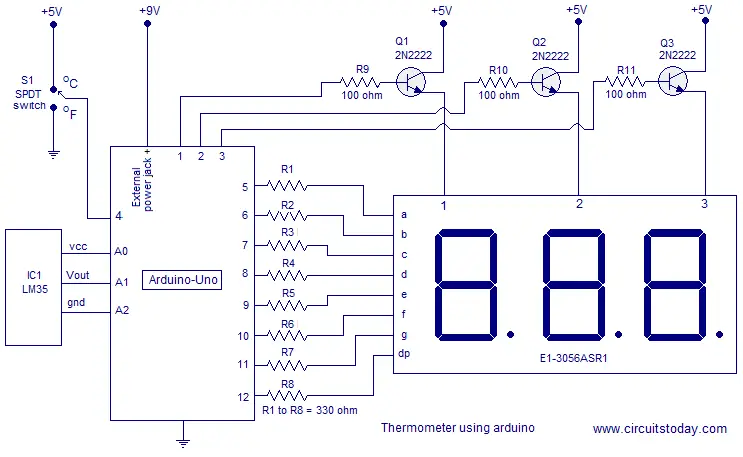Total de visitas: 10715
7 Segment Led Driver Schematic
Frequency counter with PIC and 4- to 5- digit LED display. This document describes the construction of small frequency. PIC microcontroller and a few seven- segment LED digits.
MHz (prototype worked up to 6. MHz but this exceeds. PIC's timing specifications). Hz, x. xxx MHz, or xx. MHz); or 6 digits with.

F8. FII's modification. Not sure which of these are used by the . Please do not ask me to. PICs or even circuit boards to you, my spare time is too.
If your counter shows a strange frequency initially, enter. PIC programmers don't erase the EEPROM where the. A very similar. design could be used for a single- sided printed circuit board. Four bridges. (drawn in red colour below) must be soldered on the board before fitting. Note that the crystal is mounted on the bottom.
Some of the display signal are routed with thin enamelled copper wire. If you. find some suitable low- current displays, use 1 k. Ohm or even more. Very old. displays require more current, use 3. Ohms in that case. The PIC's output.
A per pin, so the digit drivers are. Ohm resistors per segment when displaying.
If you don't have to care for power consumption and want to use old. PNP (!) transistors in the cathode(!).
There are 8 rows (indexed from 0.7) and 8 columns (also indexed from 0.7) in the matrix. If we want to light up the LED which is located at the very right of the 3.
Use the Maxim MAX7219 LED display driver with Arduino in Chapter 56 of our Arduino Tutorials. The first chapter is here, the complete series is detailed here. . or up to 8 digits of 7-segment displays. The drivers implement a SPI compatible slave interface that can be. Let's look at the schematic of the Led matrix. The 4511 is a BCD to 7-segment decoder driver. Its function is to convert the logic states at the outputs of a BCD, or binary coded decimal, counter like the 4510. The board is connected on the LED matrix board and an external MCU or Arduino. Deepack: Stepper Motor Controller: Monday, January 07, 2013 5:34:14 AM: I have checked the entire connection, but, I dont know why only 2 transistors are turning on. Seven segment LED displays are known to be resource and power hungry. But because they are visually so charming and readable from a far viewing distance and at a much. LED Solutions for LCD Backlighting Topology and architecture flexilbility Buck-Boost improved efficiency High side control in Boost topology for improved.
PIC, collector to ground, emitter to common cathode). In Germany you can - or, at least. Reichelt, look for . Do NOT use the low- efficiency types like. SC3. 9- EWA. You will be disappointed by a dark display, at least with the resistor.
Beware, other distributors of electronic components (like C.) sell such. The segment resistors were used to connect the display board. PIC board (which is usually mounted in a 9. To make connection between PIC and display board easier, a second. On this. occasion, the PIC's clock frequency was increased to 2.
This is an unique water level indicator circuit which use 7 segment LED display to show the current water level in the water tank. Most water level indicator circuits. Learn to build electronic circuits. III - Semiconductors; Vol.
MHz to have a better. The board contains the decoder. The image is 7. 00 * 3. But don't forget to place the bridge under the PIC socket before soldering. For the frequency counter, the connector pads . The 5 cathodes are not routed.
PCB - it was impossible with such a small single- layer. PCB. Use short pieces of wire to connect the square cathode pads on the display.
PIC board. Resistors R1. R4 are soldered. to the lower 4 connector pads on the display board. See photo of the second. PIC still mounted on a raster board.
Well, using the resistors to connect the CPU board with the display isn't. BTW this prototype perfectly fits in a miniature QRP transceiver called. Miss Mosquita ! But the downloadable software. COUNTER3. HEX) for common- anode.
CA). In the circuit, use PNP transistors for the CA display instead. NPN for T1 to drive the 5th digit, furthermore connect D1. D4 with reverse. polarity, and connect D4 to Vsupp (positive supply voltage) instead of GND. I used a cheap BF1. MHz and with reduced sensitivity. MHz. Make the connection from the collector to the PIC counter input. T0. CKI) as short as possible, because every p.
F of capacitance counts. The DC voltage at the collector.
R3 should almost equal - if not, adjust R2. If you. want to feed the counter with a TTL signal, leave the preamplifier away. A. If the maximum frequency in your circuit is below. MHz, you may increase the value of R3 and R2 by the same factor (say R3=1. R2=5. 6k) to save some current when using the counter in a battery- powered. R1 sets the input impedance and also the sensitivity. With R1=3. 30. Ohm, the prototype required an input voltage of 6.
Vpp (peak- to- peak) at. MHz and 1. 50 m. Vpp at 1.
MHz. If you need a higher input resistance, add. FET buffer before the bipolar transistor.
Or use a fast integrated comparator. Because there was no free. PIC 1. 6F6. 28 to drive another digit, a logic.
The schematics on the left side show one. NAND gate realized with a few diodes, one resistor, and an NPN. Of course. one could use Schottky diodes with lower forward voltages to eliminate the. N4. 14. 8 are more likely to be found in a junkbox than BAT4. For this reason, the 'single zero' (if no input signal is. With high- efficiency or low- current. With 1k. Ohm segment resistors.
A (with 5 digits .

